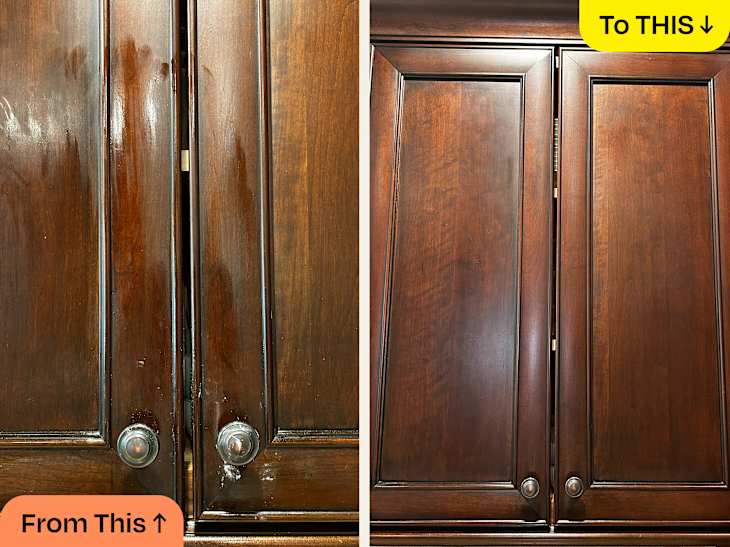

Even if you don’t cook regularly, you know how greasy the surfaces in your kitchen can get — especially the cabinets around the stove, sink, and, well, everywhere. Between developing and testing recipes for work, as well as cooking for my family, I try to stay on top of daily tasks like doing the dishes before they pile up in the sink and wiping down countertops as they get dirty, but my cabinets don’t nearly get the attention they deserve.
The previous owner of my home really prioritized kitchen storage — he built an entire wall of flat-front maple cabinets himself sometime in the middle of the last century that I absolutely love. But the downside of such sleek wooden cabinets? They show every bit of grease on my kitchen’s 33 cabinet panels and 10 drawer fronts, so you can see why tackling this job is a BIG one.
To cut down on my time and effort on it, I tested five popular cleaning methods for how to clean kitchen cabinets to see which one worked the best — and you have to see which one won.
The Best Way to Clean Kitchen Cabinets
The best way to clean greasy cabinets is to scrub them with a soft rag or non-abrasive sponge and a mixture of Dawn dish soap and warm water, then wipe away any residue with a clean, damp sponge.
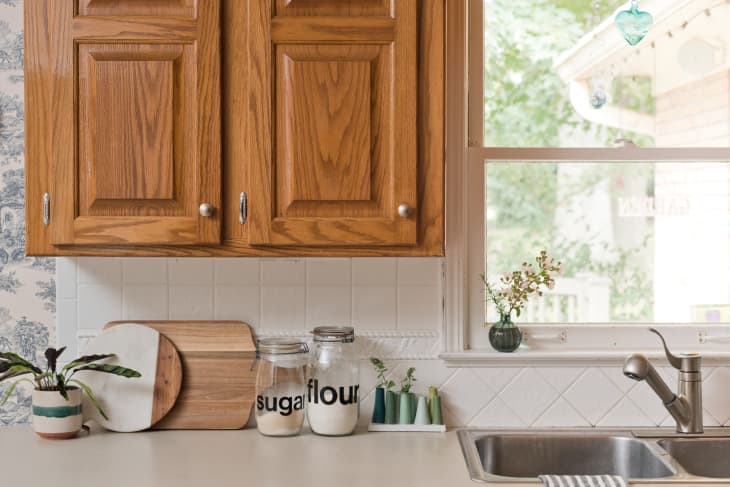
How I Tested the Methods to Clean My Greasy Wooden Cabinets
I wanted to really test each method’s ability to cut through the grime as well as the fingerprints, so I used each method on the dirtiest panels located next to my stovetop and above the oven, as well as on a mostly-clean cabinet in another part of my kitchen.
For many of the methods, I relied on a sponge cloth to apply and wipe away any of the product, but you can easily use a rag and a non-abrasive kitchen sponge, too. I set a timer to see how long it took to get the dirtiest cabinets clean. Once I tested all five methods, I finished the job with the winning method to double-check my work, and in some cases, clean up what the other methods couldn’t finish.
The ratings: Each review includes my personal thoughts on the cleaning method and what I liked and disliked about it. I rated my results on a scale of 1 to 5, with 1 being completely ineffective and 5 being the best with no room for improvement.
Note: Be sure to always check the product’s instructions before cleaning your cabinets. Spot-test if you’re unsure about your cabinets’ varnish or stain.
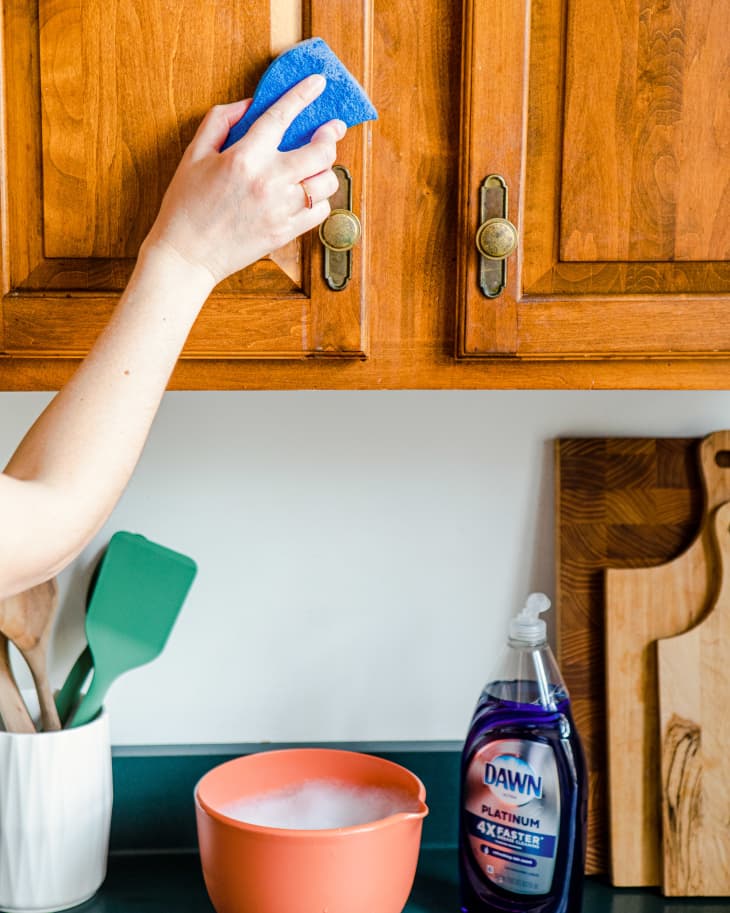
Kitchen Cabinet Cleaning Method: Dawn Dish Soap
- Cleaning time: 2 minutes per cabinet (shorter time for less dirty cabinets)
- Rating: 5/5
The method: Mix Dawn dish soap and warm water, in a small bowl, then use a sponge to clean.
How it went: This option is definitely the way to go for greasy kitchen cabinets. I put a little Dawn into a bowl and filled it with warm water, then got to scrubbing. My greasiest cabinets were cleaned with almost zero effort as the classic dish soap cut right through the grime. I then went back with a clean, damp sponge to wipe up the soap residue, which didn’t add too much extra time. As the winning method, I’m excited about how well this one worked — and I’ll go back to it time and time again!
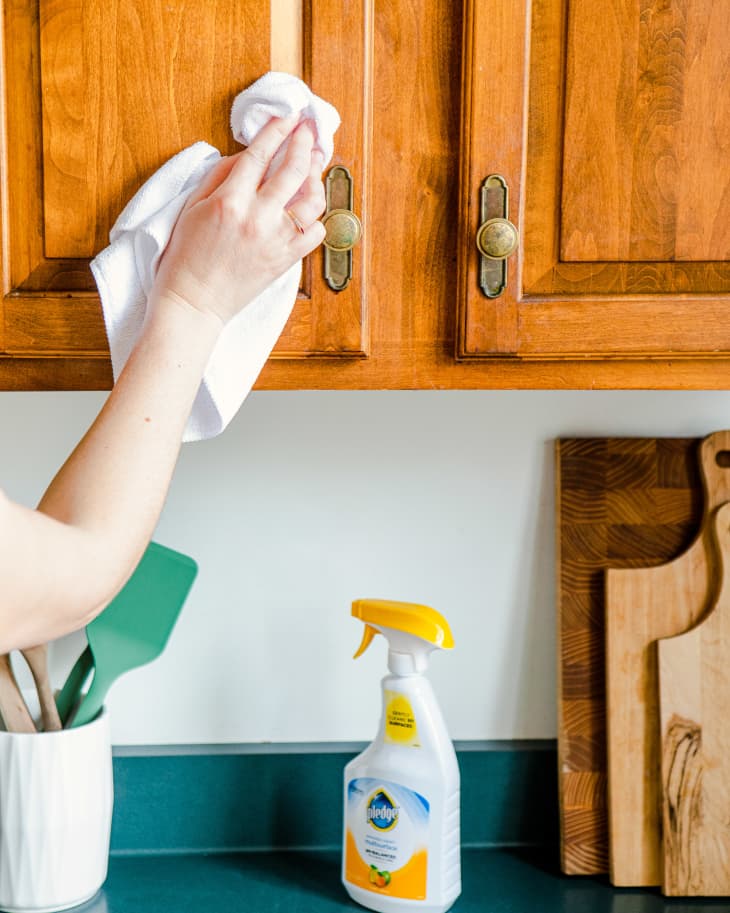
Kitchen Cabinet Cleaning Method: Pledge Everyday Cleaner
How it went: This method definitely earned points for its simplicity and effectiveness. I sprayed a cabinet, let it sit for about 20 seconds, then wiped and rubbed as needed with the microfiber cloth.
I had to scrub a little harder on the cabinets closest to the stove that were the dirtiest, but it made quick work of the cabinets that just needed fingerprints wiped away. It has a gentle citrus smell and leaves the cabinet fronts with a slight sheen that isn’t overly shiny, which I love. This would be a great option for maintenance in between full scrub-downs. I’ve even been using it on my wooden dinner table at the end of the day and love how clean it keeps things.
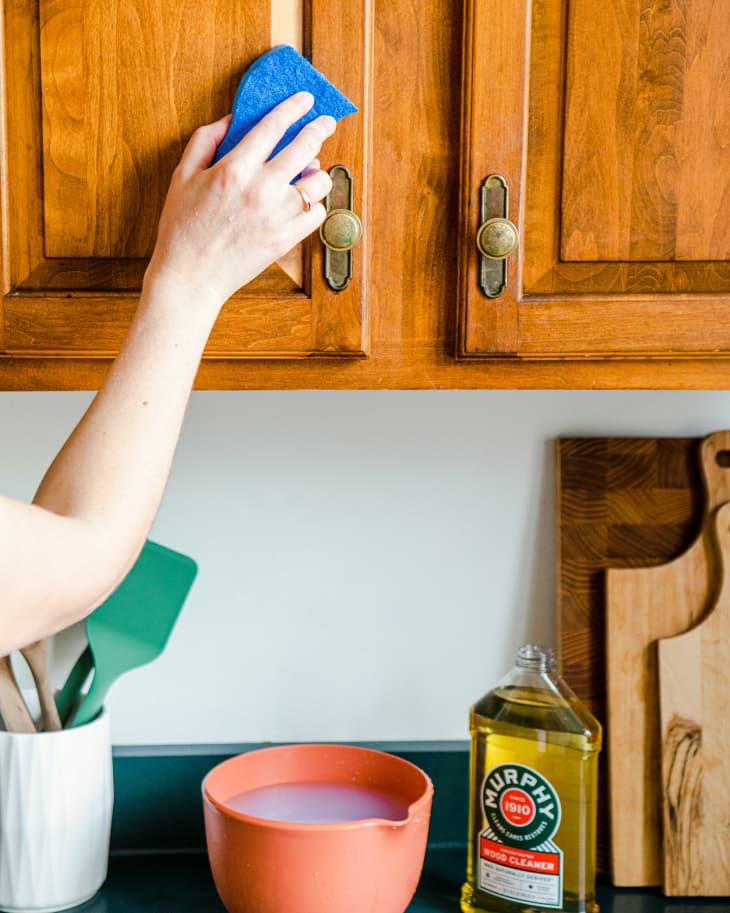
Kitchen Cabinet Cleaning Method: Murphy Oil Soap
- Cleaning time: 2 1/2 minutes per greasy cabinet (shorter time for less dirty cabinets)
- Rating: 3/5
The method: Fill a bucket with warm water and add some Murphy Oil Soap. Use a rag to wipe cabinets with the solution, then use a second rag to wipe down cabinets with clean water to remove any residue and leftover grime.
How it went: This combination did a decent job of cutting through the grease, but diluting the soap rather than just using a bottle of ready-to-go cleaner was an annoying extra step. I also did not care for the citronella scent at all, and it really lingered. Vinegar’s scent may be strong, but it dissipates quickly (more on that below). This one, while smelly, definitely did a better job than the two options below, but it wasn’t great. Overall, a solidly average performance.
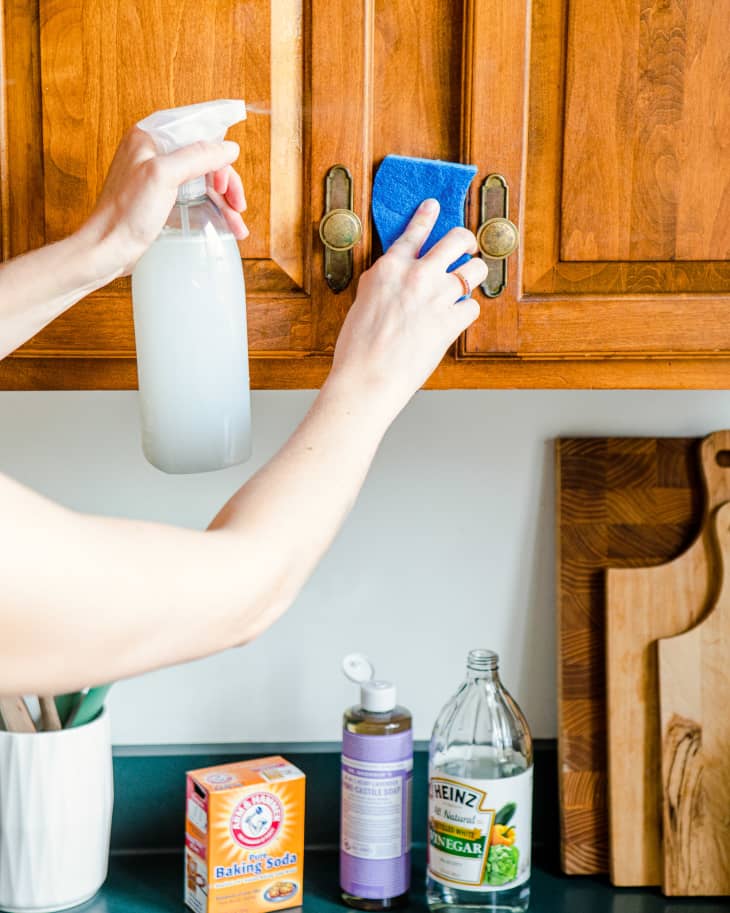
Kitchen Cabinet Cleaning Method: Castile Soap + Baking Soda + Vinegar
How it went: This concoction worked a little better than just vinegar (which I’m about to get to), but I think it had more to do with the even application from the spray bottle. I still had to scrub, and while it did cut through grease, the grime ended up balling up and was tricky to wipe away. It didn’t really clean that well, either. I went back with the winning method to clean up the mess this one made. When I used this method on a cabinet that wasn’t as dirty, it worked fine.
Making this mixture of baking soda and vinegar in a bottle was also pretty messy. I’m not sure if it was my spray bottle or the fizzing mixture, but the sprayer kept leaking even when it was just sitting on the counter. The castile soap is a semi-expensive ingredient if you’re just planning to use a few drops, but its versatility means you can use it elsewhere around the kitchen and rest of your home.
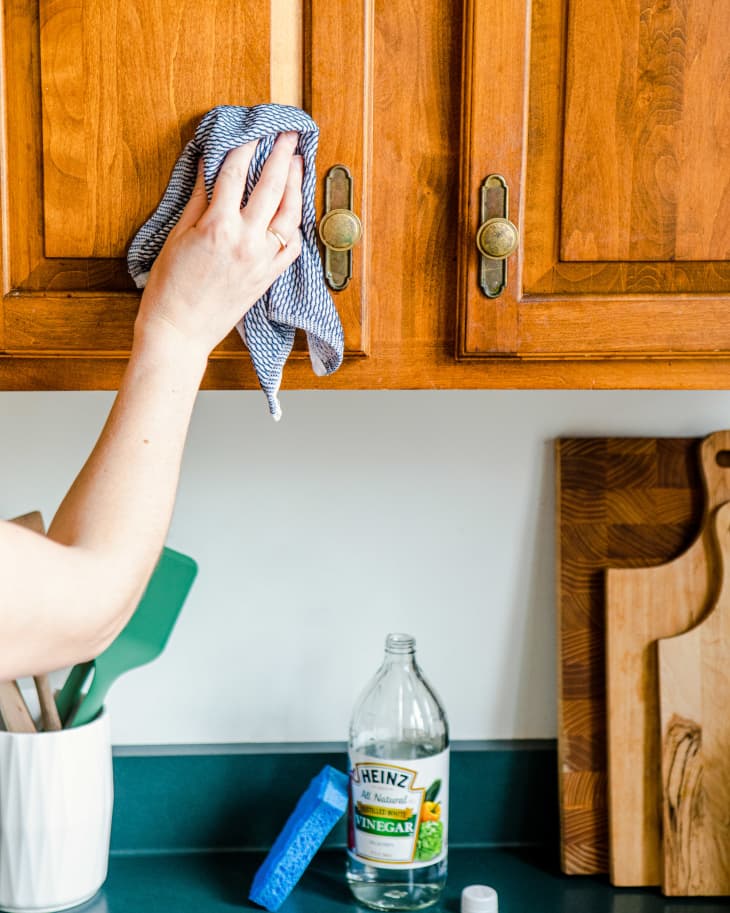
Kitchen Cabinet Cleaning Method: Vinegar Soak
- Cleaning time: 18 minutes per cabinet (shorter time for less dirty cabinets)
- Rating: 2/5
The method: Soak a washcloth in distilled white vinegar, like this classic from Heinz. Apply to cabinets, let it sit for 10 to 15 minutes, then wipe off with a damp sponge.
How it went: White vinegar’s acidity is known for cutting through grease. After applying, I let it sit for 15 minutes, but when I went back to wipe it off, it had all but dried. The damp sponge helped, but I’m not sure how much of a difference the vinegar actually made.
This method seemed to work just as well as using plain warm water. It got off the first layer of gunk, but I wouldn’t return to this method for a deep-clean. Waiting 15 minutes also made this the longest process by far, making an already big task drag out even longer. While vinegar scores points for being inexpensive, easily available, and non-toxic, it didn’t score as high in effectiveness.
Smart Tips to Prevent Grease Buildup
- Cook low and slow: Hotter oil splatters more easily. Instead, cook at lower temperatures to avoid any unwanted oil splatters. Plus, its better for your food.
- Clean up immediately: Grease only gets harder to clean the longer it sits. To prevent any buildup, wipe up any splatters immediately.
- Use a splatter screen: When cooking with oil at hot temperatures, splatters might be inevitable. But you can protect your cabinets (and yourself) by using a splatter screen, lid, or other guard while cooking.
- Use your range hood: Proper ventilation helps reduce grease buildup, so be sure to turn on your range hood while cooking to suck up any airborne grease particles.
- Clean your cabinets regularly: Don’t give that grease any time to build up by cleaning your cabinets regularly. It won’t be as big of a chore when there’s less caked-on grime.
How do you get your greasy cabinets clean? Tell us your best tips and favorite products in the comments below!




